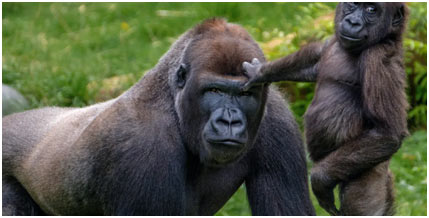What is the International Union for the Conservation of Nature (IUCN)?
The IUCN is the organization that keeps an eye on the preservation status and other eco-friendly metrics for the world’s plants and animals. Its objective is to promote sustainable use of the Earth’s resources. Founded in 1948, in Fontainebleau, France, as the Union for the Defense of Nature, the IUCN is the earliest worldwide ecological advocacy group.
Today, headquartered in Gland, Switzerland, the umbrella organization teams up with over 1,000 smaller nonprofits, associations, and governments representing 140 countries.
Add-on
Endangered Species and Types
Plants and animal species which are in danger of extinction in near future are called Endangered species. The extinction comes from habitat loss, over exploitation, pollution and threatening anthropogenic activities.
The endangered species are classified into three categories.
Critically Endangered:
species that cannot survive without direct human interference.
Threatened:
species which are somehow large in number in parts of their range but are gradually declining in total numbers.
Rare or Vulnerable species:
species that exist in relatively low numbers but are not necessarily in immediate danger of extinction.
To save endangered species, actions like research and documentation of endangered species, habitat preservation, legal actions (law and order) are needed. And almost all countries have now developed strategies for the restoration of endangered species.
Endangered(EN) Species:
Endangered species are at a very high threat of ending up being extinct in the wild. For an animal to be contributed to the classification, it must satisfy particular requirements concerning population or habitat decrease.
For some species, time on Earth is running out. Humans are the best danger to the survival of threatened species with poaching, environmental destruction, and the results of climate change triggering a lot of the issues. There are a lot of methods you can help to safeguard these animals.
One of the best ways to begin is by safeguarding the earth that we share. Basic ways to do this consist of buying sustainable items (like ones made without palm oil), cutting down on single-use plastics, minimizing water intake, and offering a Wildlife Rehabilitation Center near you.
These are the World’s Top 10 endangered species.
1.Vaquita
The vaquita is both the smallest and the most endangered marine mammal on the planet. It has actually been categorized as Critically Endangered by the IUCN given that 1996, and in 2018, there were only around 6 to 22 vaquitas left. The latest estimate, from July 2019, recommends there are currently just 9. Their most significant risk is from the prohibited fishing of totoaba, a big fish in demand because of its swim bladder.

Vaquitas inadvertently end up knotted in the gillnets set for totoaba and drown due to the fact that they can no longer swim to the surface area to breathe. Conservation efforts resulted in the introduction of a restriction on gillnets in the vaquita environment back in July 2016, however illegal fishing continues, and the risk remains. Efforts now focus on enforcing the restriction on gillnets and maltreating those that use them. Conservationists are also working to decrease the demand for totoaba, which is a protected species.
2.Javan rhinoceros
As soon as the most extensive of Asian rhinos, Javan rhinos are now noted as critically endangered. With only one recognized population in the wild, it is among the world’s rarest big mammals. There are between 58 and 68 in the wild, with none living in captivity.

The rhinos are often poached for their horns, although the loss of habitat, particularly resulting from the Vietnam War, has also added to their decline. The just population of Javan rhinos can be found in Ujung Kulon National Park on the south-western top of Java, Indonesia. The only other population, in Vietnam, was wiped out in 2010.
3.Gharial
Gharials are fish-eating crocodiles from Pakistan in the Indus River and the Ganges in India. They have long thin snouts with a big bump on the end which looks like a pot referred to as a Ghara, which is where they get their name. They invest the majority of their time in freshwater rivers, just leaving the water to indulge in the sun and lay eggs. Sadly, Gharial numbers have actually remained in decrease since the 1930s and, unfortunately, this big crocodilian is now near extinction.

There are only around 100 to 300 left in the wild. Their decline is because of a number of problems, though all human-made. Habitat loss, contamination, and entanglement in fishing net pose a few of the greatest hazards, in addition to poachers that target them for use in traditional medication.
4.Gorillas
Gorillas are remarkable creatures that share 98.3% of their DNA with human beings. They are capable of feeling emotions like we do and even behave like us sometimes. There are 2 types, the Eastern Gorilla and the Western Gorilla, and they both have two subspecies. Three out of four are Seriously Endangered on the IUCN Red List of Endangered species.

The only one that isn’t is the Mountain Gorilla, a subspecies of the Eastern Gorilla, which is considered Endangered. At the time of composing (June 2020), there are only around 150 to 180 adult Cross River Gorillas left in the wild. Like many endangered animals, their decrease is mainly due to poaching, habitat loss, illness, and human dispute. Gorillas are also sluggish to recuperate as they have a low reproductive rate, meaning females only deliver every four to six years. One woman will reproduce three or four times in her lifetime.
5.Asian elephants
Asian elephants have been considered an endangered species since 1986, as their population has decreased by at least 50% over the last 75 years or two. There are fewer than 50,000 remaining in the wild. Fragmentation, deforestation, and an increasing human population are destroying the elephants’ habitat and decreasing the area available for them to live in. The Sri Lankan, Indian and Sumatran Asian elephants can naturally be found in their nations of name and other mainland Asian countries.

Nevertheless, the very best chance to see Asian elephants is at The Event, a natural assembly of approximately 300 elephants coming to the shores of the Minneriya Tank in Sri Lanka’s Minneriya National Park during August to shower and drink. It is the largest gathering of Asian elephants in the world.
6.Leatherback sea turtles
Between 26,000 and 43,000 female sea turtles nest each year; a remarkable decrease from the estimated 115,000 in 1980. Young turtles are extremely susceptible and unfortunately, very couple of making it to adulthood. Birds and little mammals typically dig up turtle nests in order to consume the eggs. Once they’ve hatched, birds and crustaceans choose them off prior to they can make it to the sea, and fish, squid, and octopuses often prey on them if they do manage to make it into the water. The prime nesting spots for the turtles remain in Suriname, French Guiana, Grand Anse beach in Saint Lucia, Turtle Beach in Tobago, Guyana’s Shell Beach, and Gabon.

The Mayumba National forest beaches in Gabon host the largest nesting population on the African continent. April is the time to visit when around 30,000 turtles descend on the park’s beaches to lay their eggs.
7.Giant panda
Everyone likes a panda … they might be the kitschiest animal mankind has driven to the verge of extinction yet. From stuffed animals to martial arts-trained CGI abominations, we simply can’t seem to get enough of the bi-colored beasts. Though their “aww aspect” might verge on the cloying, it hasn’t lacked impact. China, which is house to the remaining wild population of fewer than 2,500 individuals, has since the late 1980s set up more strict habitat securities and poaching has banned.

Their status is still tenuous, though. Their range is fragmented and they are still subject to disease, occasional predation, and hunger when big swathes of the bamboo on which they feed finish their life cycle and pass away.
8.Lemur
Lemurs are quickly recognized by their long, bushy tails and clear eyes, and found just on Madagascar and the Comoro Islands. This location is found on the southeast coast of Africa. These unique animals are the most threatened of all primates.

More than 100 different types of Lemur are found, all of which are endangered. There is nearly no Lemur staying today, of any species. Although they are not on the list of critically endangered species, there are few of these animals found at few places.
9.The Saola
The Saola or sow-la is likewise referred to as the Asian unicorn. It is hardly ever seen these days. The animal is quite big and has been around because 1992, though seen just on unusual celebrations. It is considered a seriously endangered animal and is discovered just in the Annamite Mountains of Laos and Vietnam.

Saolacabn can be determined by two parallel horns with sharp ends on both males and females, which can reach 20 inches in length. Known by “spindle horns” in Vietnamese, it looks like livestock or an antelope and has striking white patches on its face and large maxillary glands on the muzzle, which could be used to mark the area or attract mates.
10.Siberian Tiger
The Siberian Tiger is the largest feline found worldwide. The Siberian tiger was also called “Amur tiger”, “Manchurian tiger”, “Korean tiger”, and “Ussurian tiger”, depending on the area where individuals were observed. It can weigh as much as 650 pounds.

This species of the tiger can be found in the birch forest of Russia and Far East China and Korea. These tigers often reside in locations with wintertime temperature levels very cold, some as much as -50 degrees F.This tiger is becoming extinct due to hunting. A more in-depth census revealed a total population of 562 wild Siberian tigers in Russia. It is unlawful to hunt a Siberian tiger.

